If
Batman Begins (2005) was about Bruce Wayne learning to master his fears and use his new found knowledge to protect the innocent citizens of his hometown with what he learned, then
The Dark Knight (2008) is about the escalation of violence by Gotham's criminal underworld in reaction to Bruce Wayne's efforts to terrorize them as the Batman. As the mobsters' slice of the Gotham pie decreases day by day, they pool their efforts together to counterattack Batman. In their shortsighted attempt to destroy Batman, the criminals look to a man who seems capable of out-terrorizing even Batman himself, an agent of chaos known only as
The Joker.
THE DARK KNIGHT
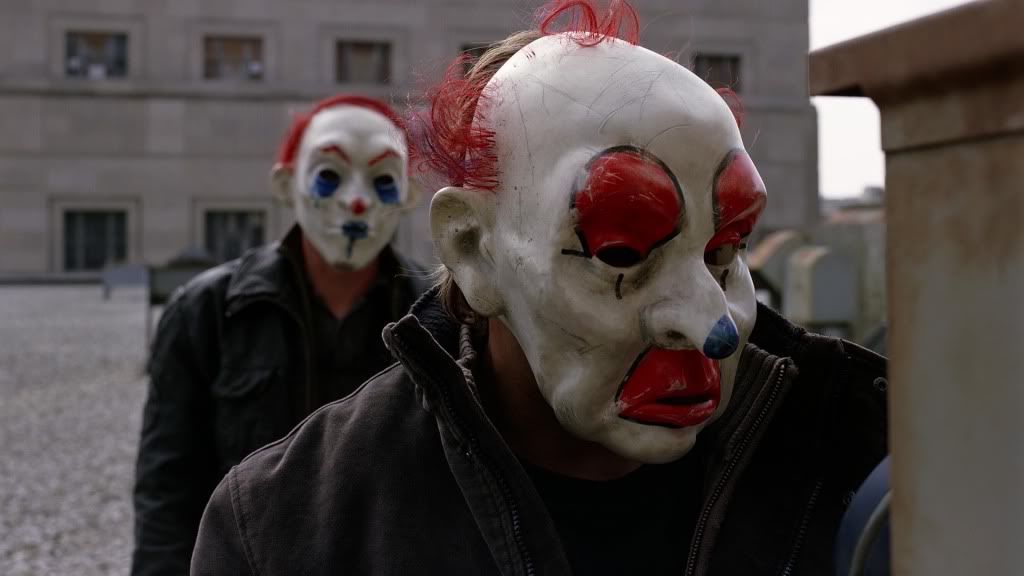 |
| Villain #1: Chaos, the Joker Turns Partner Against Partner and Dog Against Master |
Even more destructive than
The Joker himself, is the poisonous philosophy he spreads in his wake. We learn this philosophy through its practice before
The Joker reveals himself in the opening scene. A team of criminals rob a mobster-controlled bank, but as soon as any of them finish their assignment, the next pawn up the hierarchy kills them for the hope of a larger share. In a brilliantly duplicitous way,
The Joker hedges his bets by setting each of his henchmen against the others until
The Joker is left standing. As fear was the overriding abstract villain for Bruce Wayne to defeat in Batman Begins, now The Joker's philosophy of chaos threatens to tear Gotham apart.
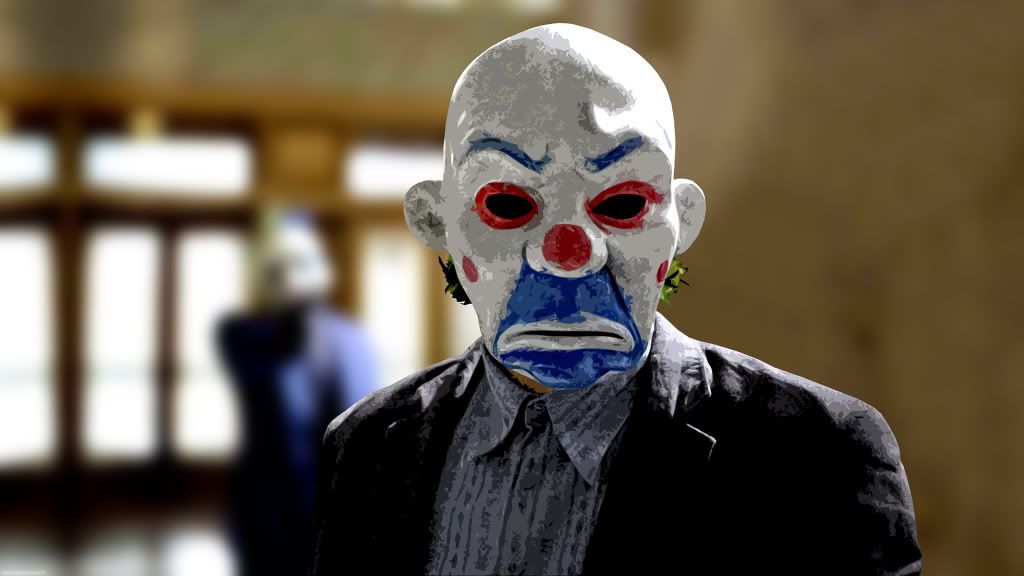 |
| Villain #2: The Joker
|
The Joker gleefully describes himself as an agent of chaos, and it soon becomes clear The Joker is as dedicated to this role as the Batman is to upholding his role as Gotham's protector. Because of Batman's dedication to upholding a chivalrous code, it makes sense why Batman begins to be known by another title this film: the Dark Knight. In antiquity, honorable knights lived by a strict code to protect the helpless and innocent. The Joker on the other hand is the polar opposite, attempting to prove that deep down no one is helpless or innocent. He will stop at nothing in his quest to bring good people down to his level, in his mission to eradicate humankind's belief in a safe society built up by rules of behavior and codes of conduct
The Joker does not seek money, love, acceptance, or popularity.
The Joker is an ideological beast that only wants to watch the world burn. While the Dark Knight attempts to provide another check and balance to a broken system, The Joker simply wants to destroy all systems
and unleash the id hiding behind everyone's ego and superego. He conceals his identity behind a completely blank paper trail of an existence and constantly lies to his victims about how he got those scars. So The Joker seems obsessed with uncovering the deepest recesses of everyone's identity but his own. And there's no brownie points to be earned with The Joker. If he cannot find a way to corrupt you, he might let you live until he does. But he will eventually kill off anyone and everyone who chooses to work with him.
 |
| Villain #3a: Chechen, Gotham's Russian Crime Boss |
The next three villains really represent different aspects of the same villain, namely the archetypal organized crime boss. Each man has painstakingly worked themselves up the ranks of leadership in their respective crime families. Each man participates in a crime council where they liaise with each other about their respective projects and territories, partly to stay out of each other's way, but also to provide aid and assistance. We will call them a fraternity of crimelords. Chechen is brutal and is the first of Gotham's crime bosses to acquiesce to
The Joker's offer/demands to kill the Batman. The Joker shows his gratitude by co-opting Chechen's criminal organization, chopping up his body and feeding him to his own guard dogs.
 |
| Villain #3b: Salvatore Maroni, Gotham's Italian Crime Boss |
Salvatore Maroni succeeded Carmine Falcone as Gotham's Italian Crime Boss, apparently the strongest of Gotham's three mafia syndicates. Early in the film, District Attorney Harvey Dent attempts to put Maroni behind bars, but Maroni manipulates the trial into an unsuccessful assassination attempt on Dent's life. Maroni is ambivalent about going into business with
The Joker, but Batman's eventual abduction of his money launderer Lau will nudge Maroni off the fence to join Chechen in hiring The Joker to eliminate Batman for them. Maroni is repaid by The Joker's accolyte Harvey "Two-Face" Dent, who shoots Maroni's driver on a coin flip.
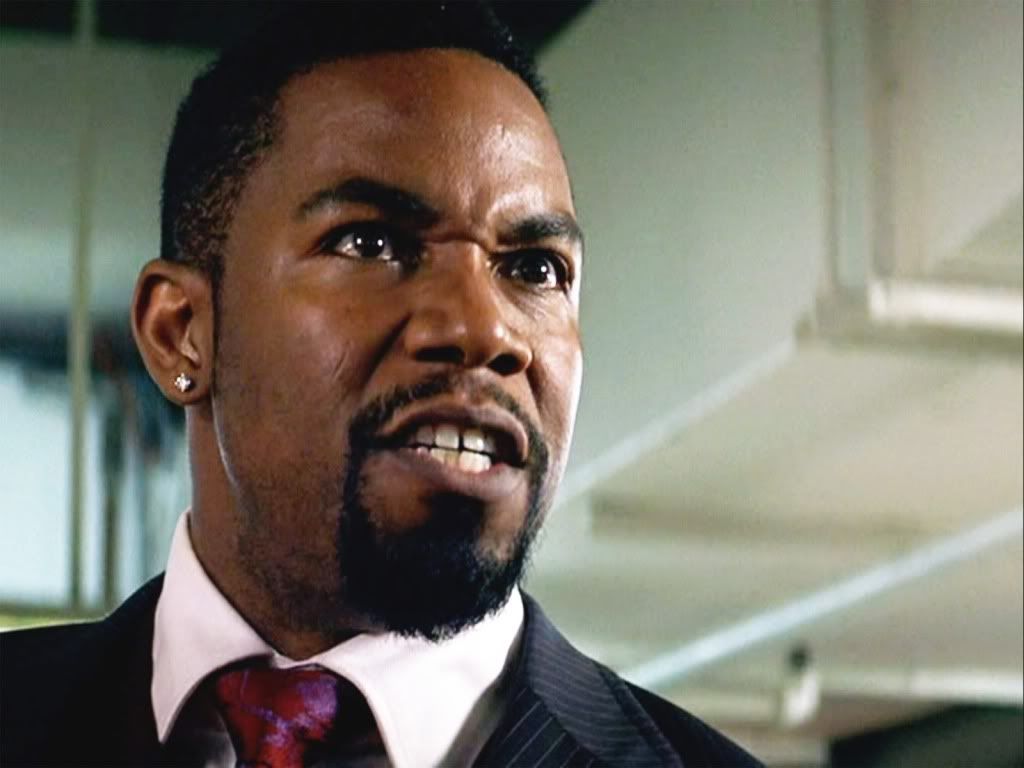 |
| Villain #3c: Gambol, Gotham's African-American Crime Boss |
And then we look to the crime boss most militantly opposed to hiring
The Joker, African-American Crime Boss Gambol. Of all the three mobsters, Gambol is the only one of them to recognize The Joker for the dangerous and degenerate terrorist he really is. Unfortunately, Gambol underestimates The Joker's resourcefulness and falls prey to a Trojan Horse early in the game. Among Gotham's Crime Bosses, Gambol stands out as a better judge of character and probably had the most integrity of the three, which is partly why The Joker eventually kills him to get the ball rolling with the other two Crime Bosses.
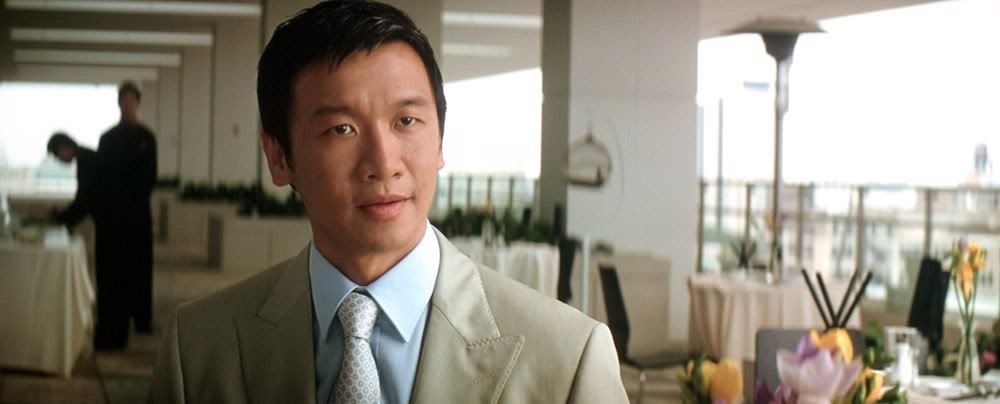 |
| Villain #4: Lau, C.E.O. of a Chinese Corporation and Mob Money Launderer |
Harvey Dent prosecuted and convicted every money launderer in Gotham, leaving the Crime Bosses to entrust their money with a Chinese foreign national with his own corporation to help justify his frequent excursions to Gotham.
The Joker correctly surmises Lau is a slippery white collar criminal who is vulnerable to Batman and will turn state's witness given half a chance. Lau has a fascinating implied back story, because he is clearly the wealthiest criminal that Batman has had to face and he lives in a veritable fortress with police and government protecting him when his guards are insufficient.
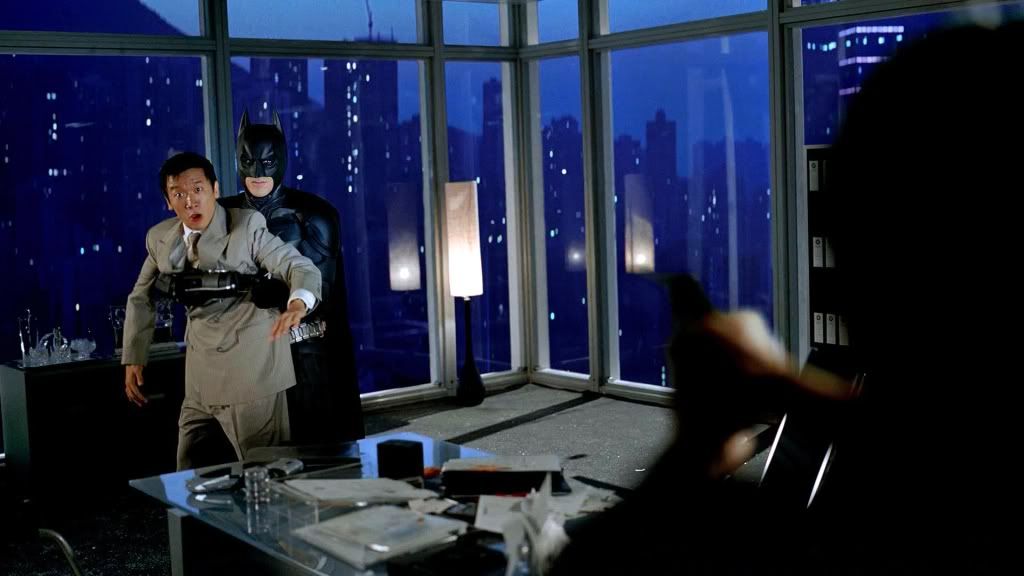
This provides an interesting grey area for Batman fans, who many could argue only has a right to perform vigilantism in his own backyard, if he has any right to to perform it at all. This is really the first instance when Batman has pursued his crime-fighting agenda outside of Gotham itself. While Bruce Wayne has had journeys to the far east, eventually joining and in turn destroying the League of Shadows in Batman Begins--Batman was always intended as a symbol against Gotham's criminal underworld and not a globe-trotting hero like Superman or the Green Lantern (also in the DC Comic Universe). As many have noted previously, this is just one of this film's many parallels with the U.S. during the course of its War on Terror. Batman is doing a thinly veiled rendition of an enemy combatant, and then leveraging him against the Gotham mob.
 |
| Villain #5: Colman Reese, Mergers and Acquisitions Attorney for Wayne Enterprises
|
Unlike most of Bruce Wayne and Batman's villains, Colman Reese is really a borderline criminal at worst. Reese does not really seem like a man who wants to live a life of crime per se, but just chooses to capitalize on secret information he stumbled upon in verifying the due diligence of a potential merger with Lao's company. In this respect, Reese is really an audience stand-in for a regular Joe whose eyes started to get full of dollar signs. In some ways, this amoral ambiguity makes Reese one of the least sympathetic villains in the trilogy. All of Batman's other villains at least have a set of convictions they stand behind, even if those convictions are insane and evil. Colman Reese, on the other hand, is just jockeying for some short-sighted leverage.
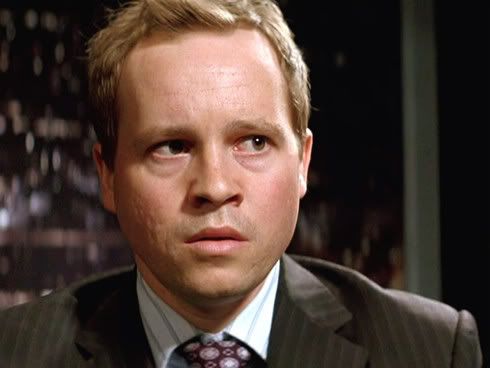 |
| Short-Sighted, Self-Serving, and Super-Slimy = A Typical Gothamite |
At first, Reese just wanted hush money to keep silent, but later he attempted to capitalize his knowledge for fame, money, and potentially for the ethical dilemma of letting
The Joker continue killing cops each day Batman did not come forward. But
The Joker intended this as a personal challenge to Batman, and never intended for this slimy lawyer to ruin his test of Batman's mettle. So
The Joker threatens to blow up a hospital if someone in Gotham does not kill Reese first.
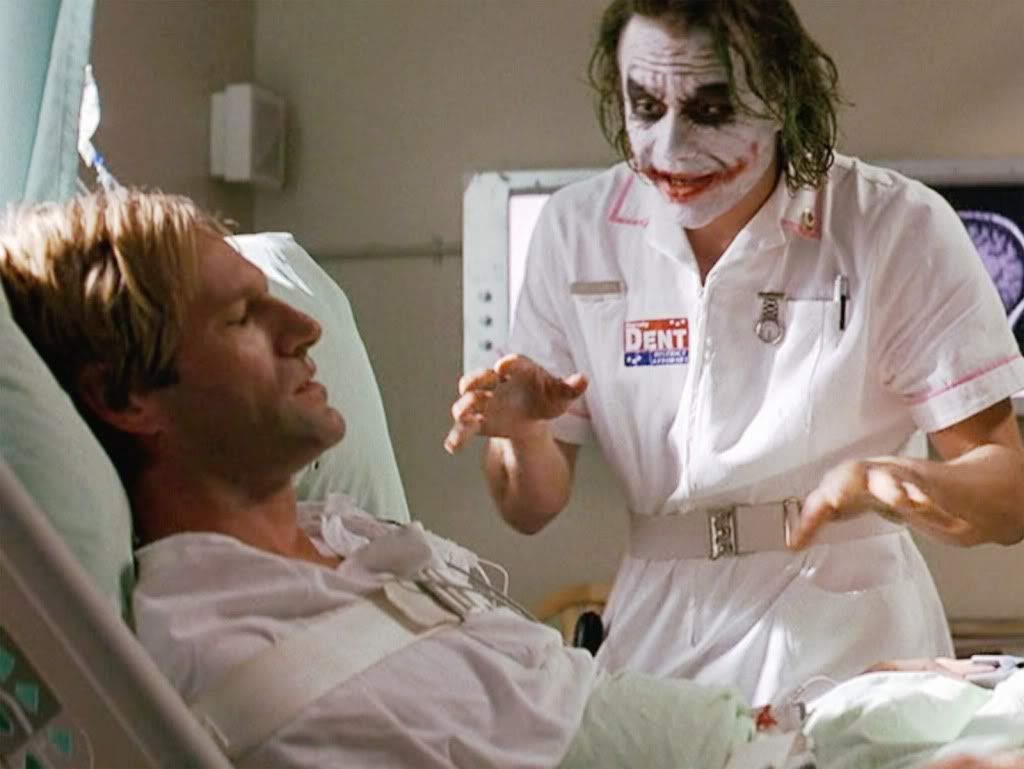 |
The Joker Needed to Buy Time to Prepare the Ace Up his Sleeve to Undo All
the Good Batman, Commissioner Gordon, and Harvey Dent did for Gotham |
The Joker was already preparing to blow up Gotham General Hospital. But this was an effective gambit to kill two birds with one stone. This would effectively silence Reese so that his personal challenge to Batman stood. It also caused chaos in the city sufficient to distract Batman and the police while The Joker converted Harvey Dent to his way of thinking.
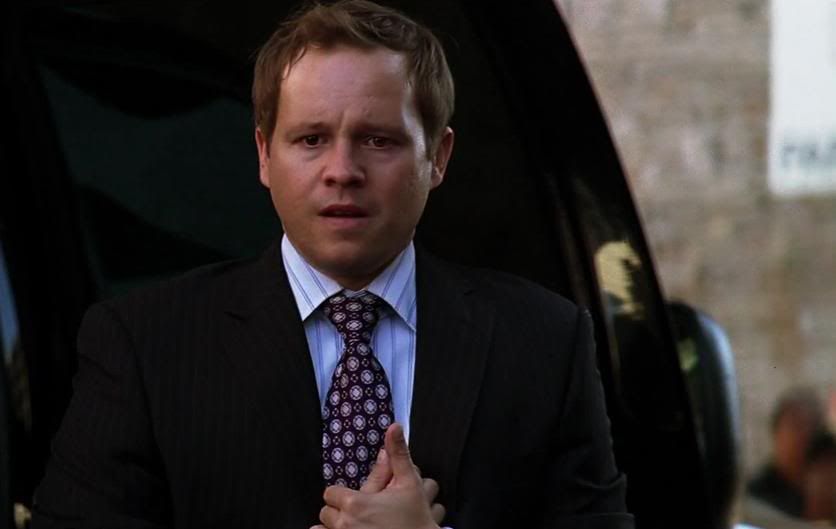 |
| A Singular Moment of Contrition by One of Bruce Wayne and Batman's Rogues Gallery |
Bruce Wayne had every right to leave Colman Reese in the cold when The Joker made his threat. Which gives Bruce Wayne's moral stance to protect the citizens of Gotham even greater weight when he ultimately saves Reese's life. The shame in Reese's eyes when confronted with an injured Bruce Wayne, who put himself (and his Lamborghini) at risk to save his life was enough to silence Reese for good, without intimidation or threats. Reese is one of the few villains Batman manages to convert throughout the trilogy. And he did not do it with his conventional arsenal of fear an intimidation, but through forgiveness and a generous sacrifice.
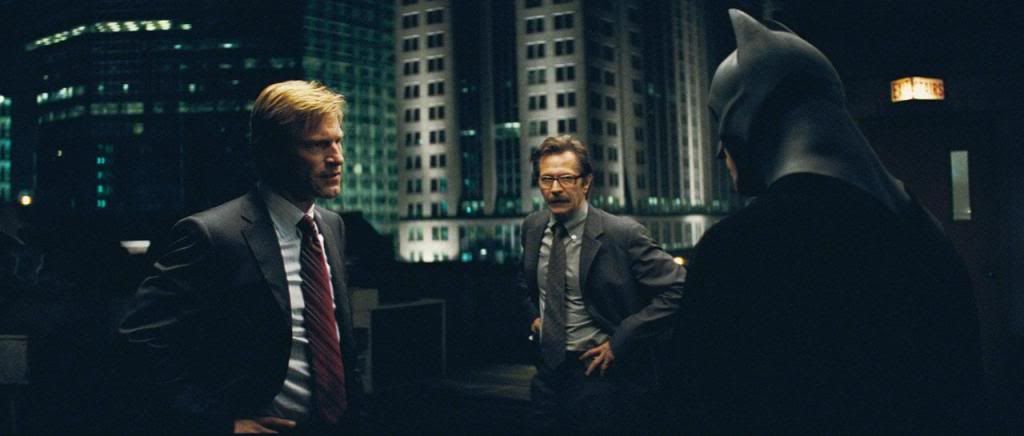 |
| Villain #6: Glaring Corruption Allowed to Exist Within the System, Police Officers on the Take |
Officers Wuertz and Ramirez work for Gotham Police Department and were controversially assigned to Jim Gordon's Special Task Force against organized crime. District Attorney Harvey Dent objected to their presence on the task force, having investigated them for corruption amd criminal activity while he worked at Internal Affairs. Harvey turned out to be correct when Officers Wuertz and Ramirez were revealed as spies and operatives of Salvatore Maroni. Like Detective Flass in Batman Begins, Wuertz and Ramirez are corrupt cogs in the broken machine of Gotham, and represent the reason why a crime-fighting masked vigilante like the Batman became necessary.
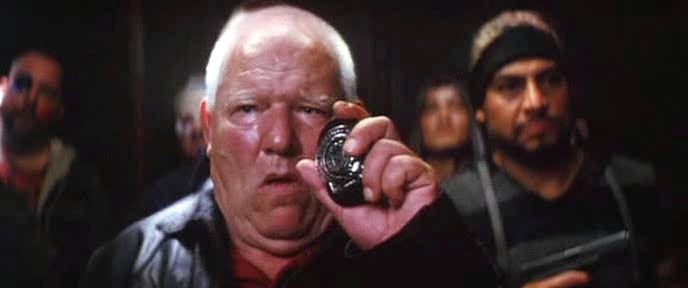 |
| Villain #6a: Officer Wuertz, Corrupt Cop on Gordon's Special Task Force |
Wuertz shares a lot in common with Detective Flass from Batman Begins. Aside from their greed and similarities in physical apperance, both men have an unpleasant demeanor and act abrasive to others by virtue of the protection they have by wearing a badge. For public relations reasons, Wuertz was assigned by Jim Gordon to uncover the identity of Batman, but that assignment was clearly just for show as the case board revealed his Batman suspects as Bigfoot, Elvis, and Abraham Lincoln. Wuertz never shows any signs of remorse for his crimes until Harvey "Two-Face" Dent places a gun in his face and pulls the trigger for his part in the kidnapping and murder of his Assistant District Attorney and fiance Rachel Dawes.
 |
| Villain #6b: Officer Anna Ramirez, Corrupt Cop on Gordon's Task Force |
Officer Anna Ramirez, on the other hand, does show signs of remorse throughout the movie. Her mother is chronically in the hospital for an unknown illness and the medical bills keep piling up. Unlike Flass, Wuertz, and Colman Reese, Ramirez is acting out of desperation more than out of a desire to make fat stacks of cash. Ramirez places in danger the lives of her fellow officers and public officials, but Ramirez likes to think of her corruption as selfless since it is ostensibly done to save her mother. Ramirez helps prolong a brutal mob war and destroys the lives of many innocent people, including the love of Bruce Wayne's and Harvey Dent's lives. Ramirez evades Two-Face's revenge on a coin flip and her fate is left unclear throughout the rest of the
Dark Knight Trilogy.
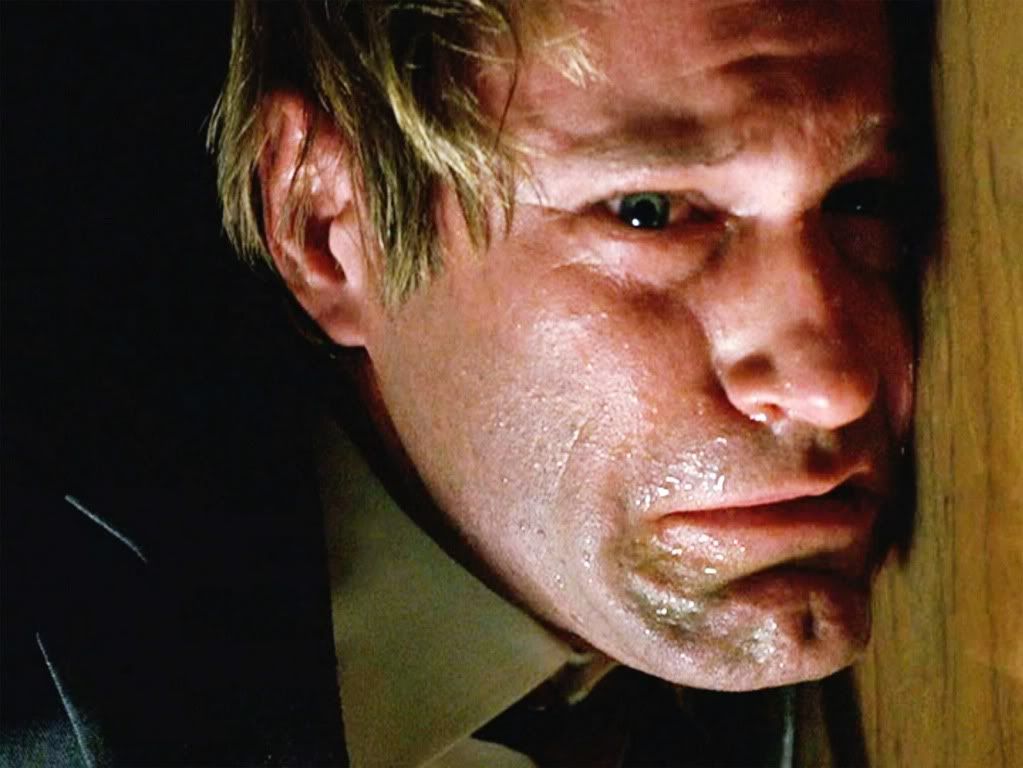 |
| Villain #1a : Chaos, Batman Must Choose to Save Harvey Dent or Rachel Dawes |
The Joker strikes out at Batman personally and forces the Caped Crusader to choose one of two lives to save from a fiery explosion: Rachel Dawes or Harvey Dent. District Attorney Harvey Dent was the most necessary component to turning Gotham around and purging the corruption in the system, yet
The Joker detected genuine feelings of love and romance in Batman for Rachel Dawes. At the Dent fundraising party The Joker pushed Rachel off a skyscraper and Batman abandoned a large room full of Gotham's elite at risk from The Joker to fling himself after Rachel alone.
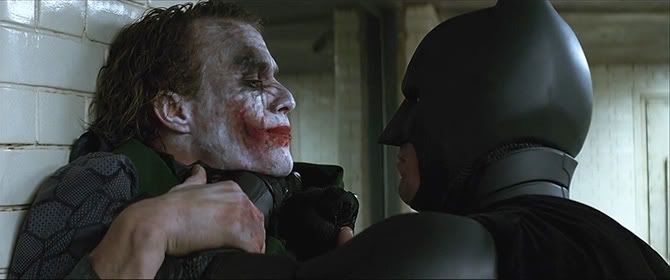 |
| The Joker's Philosophy of Chaos Demands Lose-Lose Scenarios to Drive People Insane |
The Joker gives Batman just enough time to rescue one of them before the explosives go off, but reverses the addresses of where they are being held. The Joker wants to break Batman's ethical code, provoke him to the point of making him homicidal and kill The Joker in response. He essentially wants to become Kevin Spacey's serial killer character at the end of David Fincher's Seven (1997), whose ultimate philosophical victory is to break his opponent to prove his chaotic philosophy of life correct.
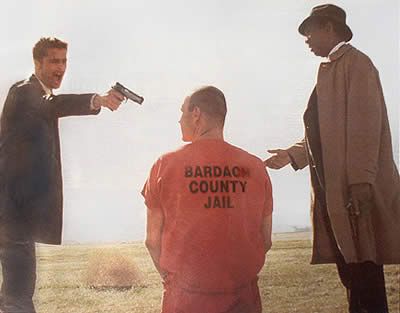 |
| The Joker Pulls a 'Seven' on Batman |
So The Joker reverses the addresses where Batman can find Rachel and Harvey, thereby killing the person Batman cares about most. Batman said he lives by only one rule. In Batman Begins (2005) he demonstrated that that rule is not killing people. And The Joker wants to ensure that by the time this is all over, in some way Batman will feel responsible for the death of the person he cares about most.
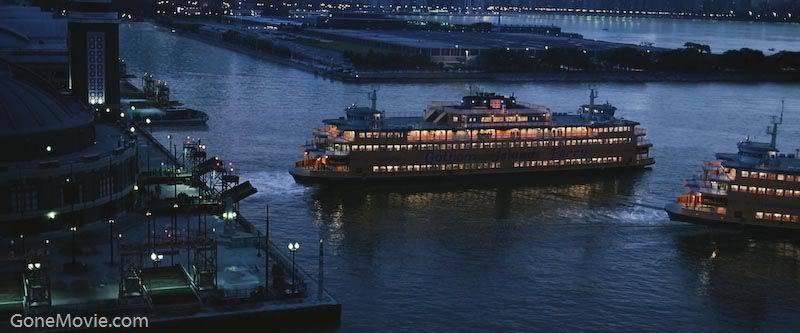 |
| Villain 1: Chaos, The Joker Forces One Boat Full of Gotham Citizens to Eliminate Another One or Both be Destroyed |
This next class of villain is more of an abstract concept that is taking root in several Gotham citizens, namely The Joker's philosophy of chaos. In an attempt to prove that human beings are vicious and selfish by nature, The Joker sets up what he calls "a sociological experiment." The Joker hijacks the controls of two ferries by remote, each filled with Gothamites. One ferryboat is filled with Gotham's most dangerous criminals being transferred from prison. The other ferryboat is filled with everyday civilians. The Joker rigs both ferries to explode and offers the remote detonators to the passengers of each vessel. If anyone attempts to jump off the ferry, The Joker will blow up both boats. If neither boat's passengers makes a decision by midnight, The Joker will trigger both boats to explode.
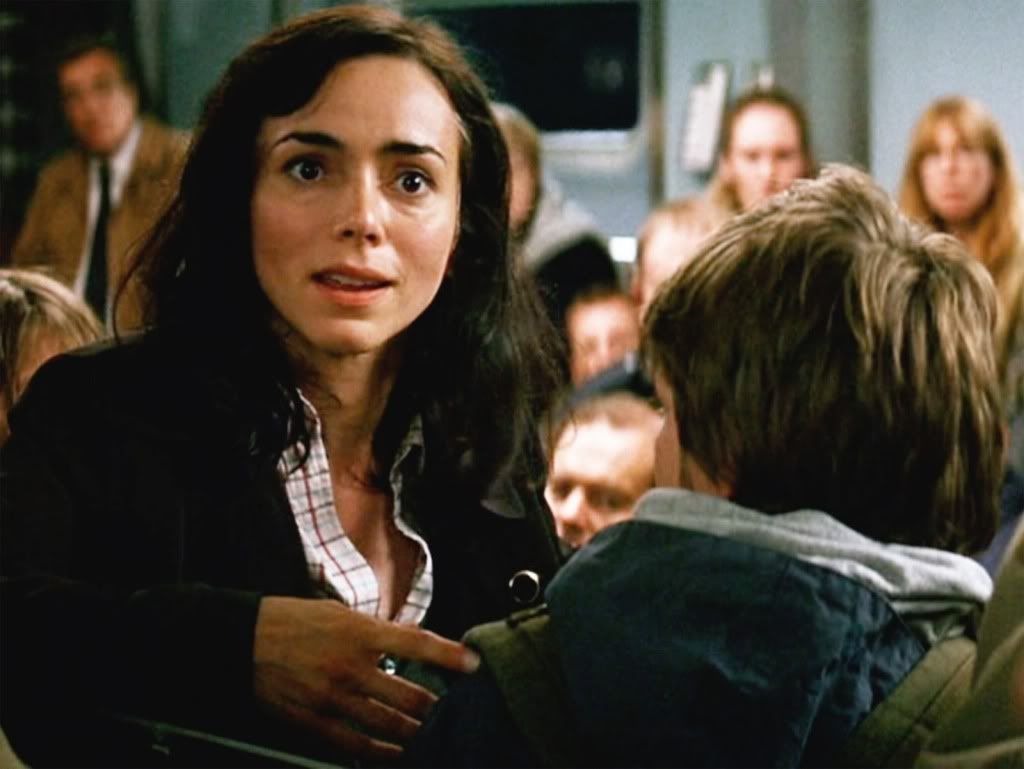 |
| Villain 1b: Fearful Mother Riding a Ferry Hijacked by the Joker |
Although not conventional villains, there are three morally challenged ferryboat passengers given particular emphasis during this scene. The first is an average mother, who was simply trying to escape Gotham with her son to avoid getting caught in the very game she now finds herself. When the ferryboat captain with the remote trigger refuses to discuss the possibility of murdering the people on the other ship, this mother helps lead the cause for putting the issue up for a vote. She argues for the sanctity and value of these passengers' lives over that of the prisoners' lives. Like Ramirez before, this mother seems to have some remorse and second thoughts about her rashness when the vote is overwhelmingly in favor of blowing up the boat of prisoners.
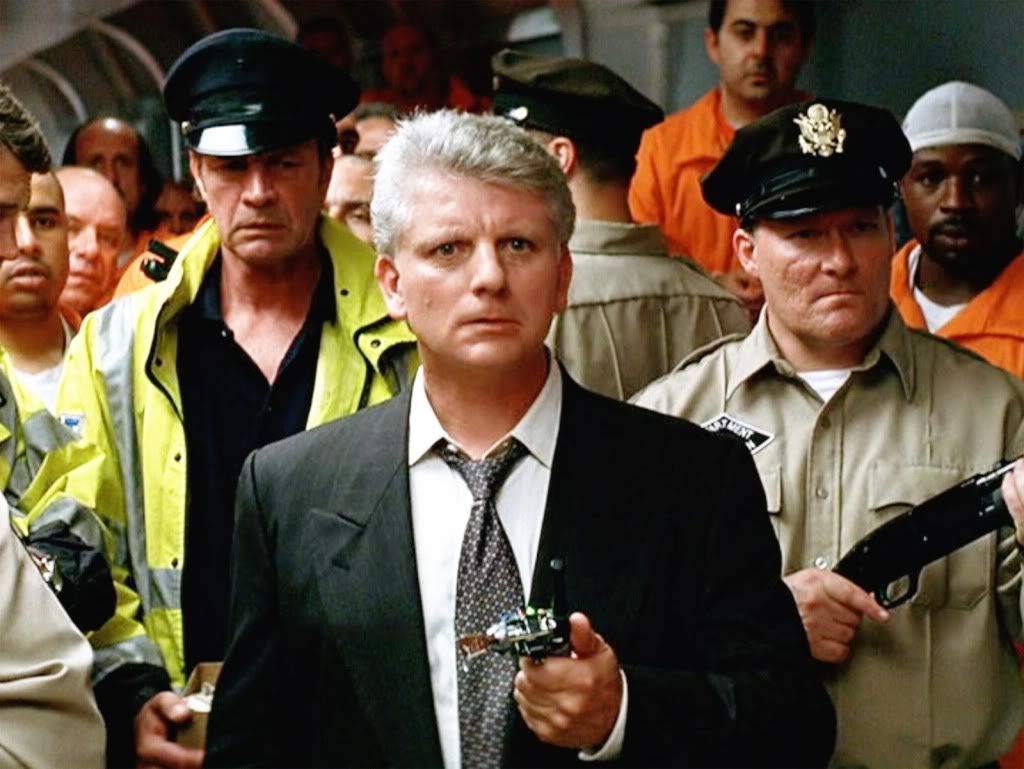 |
| Villain 1c: Fearful Prison Warden Riding a Ferry Hijacked by the Joker |
The next villain is intriguing since his only wrongdoing is that of omission. That is, the prison warden seems like a relatively good and honorable man generally speaking, but when his life is at risk he selfishly keeps the remote trigger in hand in spite of the criminals who will surely wrest control of it when the deadline approaches. In a powerful moment, an intimidating murderer convinces the warden to hand the device over to him for the purpose of triggering it, but throws the remote trigger out the window of the boat instead. In the words of the prisoner, "I'll do what you should have did 10 minutes ago."
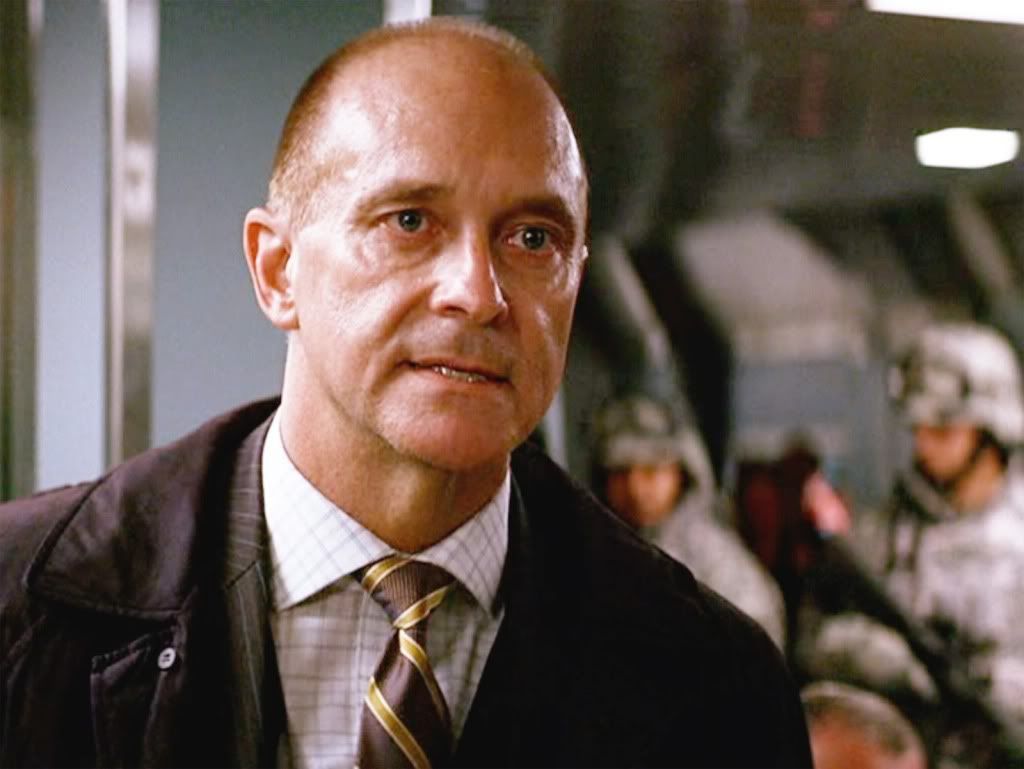 |
| Villain 1d: Coldly Pragmatic Gotham Citizen Riding a Ferry Hijacked by the Joker |
And finally there is the coldly logical intellectual who declares definitively that his ferryboat of civilians is ethically in the right blowing up the ferryboat of criminals, and that it makes no sense for all the passengers to die in both boats. He led the debate for putting the matter of the detonator up to a democratic vote and when everyone else aboard the ferry shirked in the face of murdering the passengers of the other boat, he boldly pronounced the righteousness of their cause and offered to be the executioner. The ironic aspect to this villain is that ethically he's right: killing the boat full of criminals is logically the best option. But morally, he's wrong: killing others simply to spare yourself from getting killed by a third party leads to the utter corruption of your soul, something the man finally discovers when he ultimately stops himself from triggering the detonator.
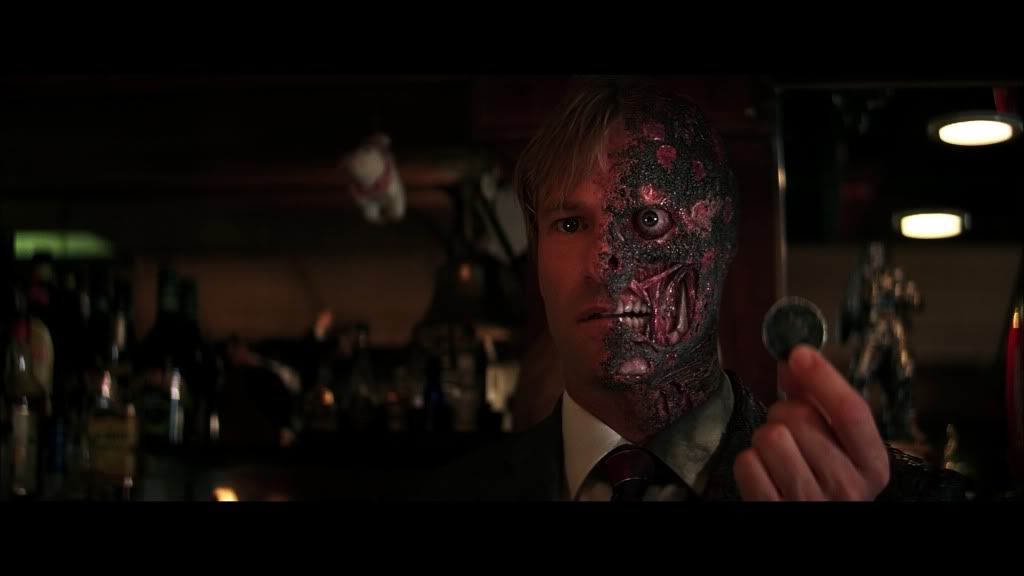 |
| Villain #7: Harvey "Two-Face" Dent, the Only Thing Fair is Chance... |
Arguably,
The Joker's greatest success was in converting Gotham's White Knight, Harvey Dent, into a demented killer bent on revenge. Batman's greatest goal was to help usher in a Gotham where a Batman would no longer be needed. Commissioner Gordon, District Attorney Harvey Dent, and Batman put their lives on the line and risked everything in pursuit of this goal. So when
The Joker robbed Harvey of his true love and half of his face,
The Joker also robbed him of his sanity. In this state, Harvey was susceptible to The Joker's philosophy of chaos and made it his own.
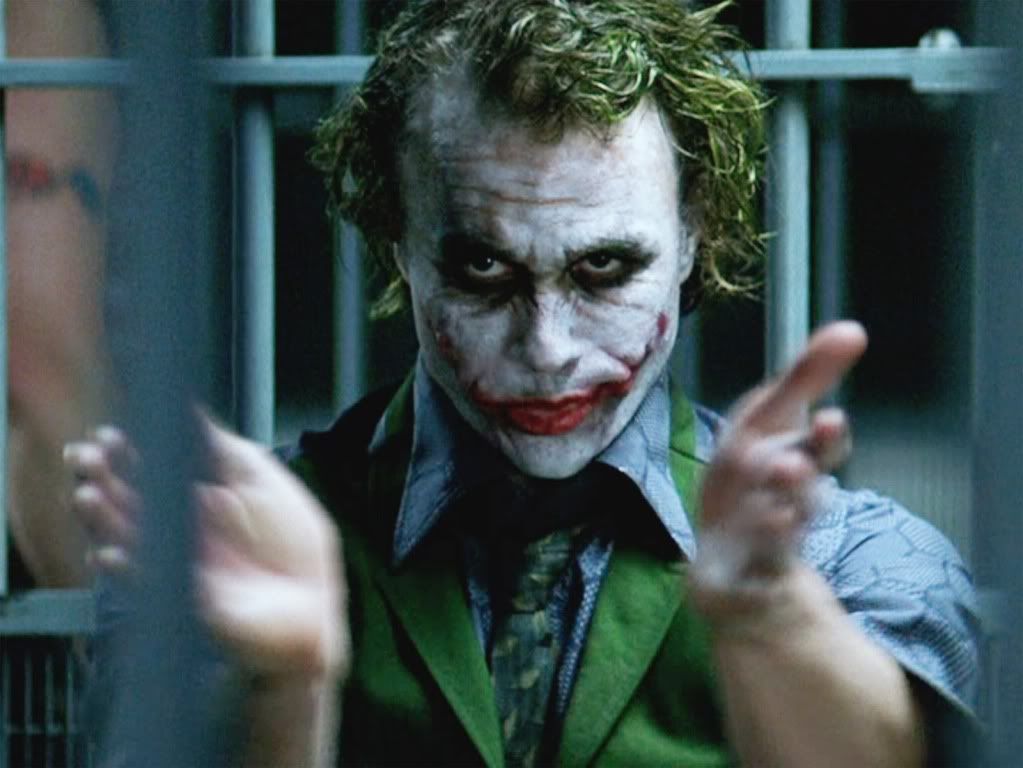 |
The Joker Wishes to Cause the Ultimate Inversion and for Chaos to Reign
in the Wake of Gotham's Fallen Hero Going Mad with Revenge |
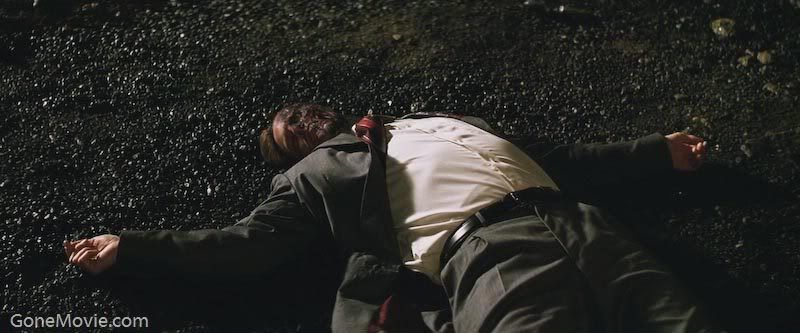 |
| The Villain Gotham Deserves... |
As Two-Face, Harvey Dent goes on a one-man killing spree and even holds Commissioner Gordon and his family hostage, the life of Gordon's son subject to the whimsy of a coin flip. Batman pleads with Harvey to come back to his senses, but only Two-Face exists now. Batman must kill Harvey to save Gordon's son. With Commissioner Gordon and Batman standing on the precipice of defeat, facing a future of a demoralized Gotham sinking lower and lower into crime and corruption, Batman sacrifices the symbol of Batman and takes the blame for Harvey's murders and allows his justifiable killing of Harvey to be labeled a senseless murder instead.
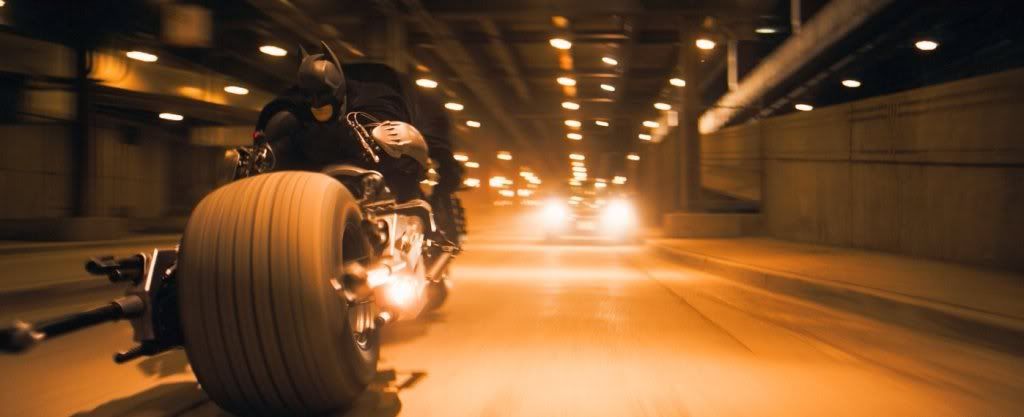 |
| ... But Not the One it Needs Right Now |
Batman sees that this is the best way to honor the legacy he's created. All that matters to him at this point is beating back
The Joker's philosophy of chaos before it consumes Gotham permanently. As Commissioner Gordon informs his bewildered son,
"... [H]e's the hero Gotham deserves, but not the one it needs right now. So we'll hunt him. Because he can take it. Because he's not a hero. He's a silent guardian, a watchful protector, a dark knight."
Previous Article
Next Article
Bruce Wayne and Batman's Rogues Gallery:
The Dark Knight Rises (2012)






















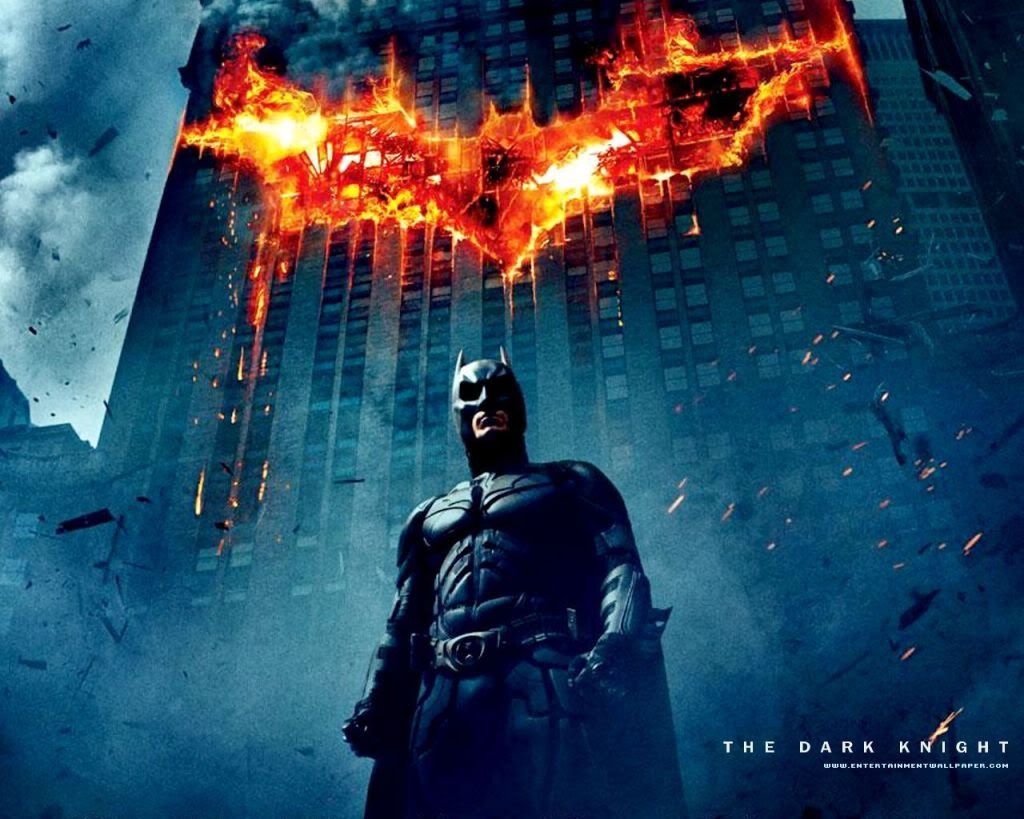
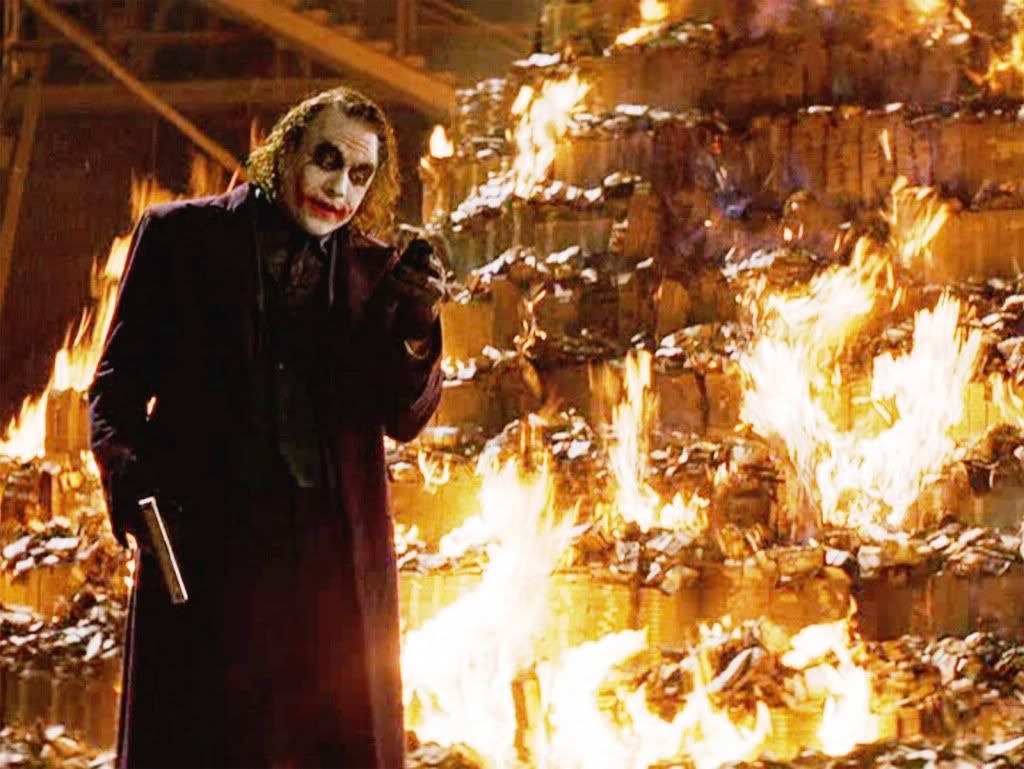



No comments:
Post a Comment